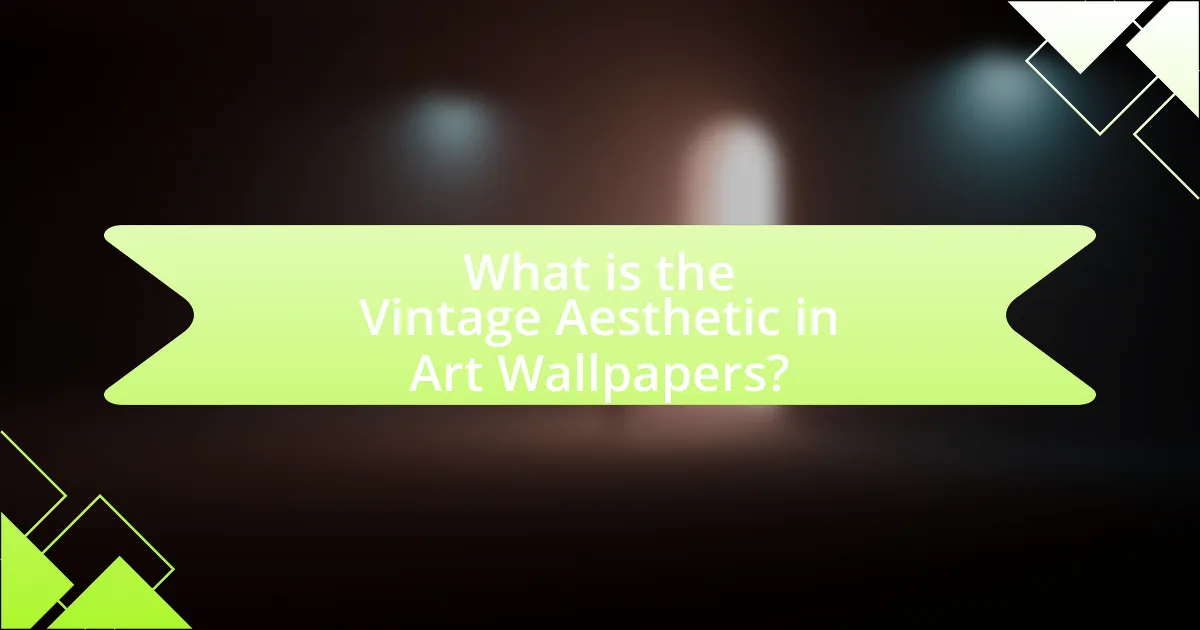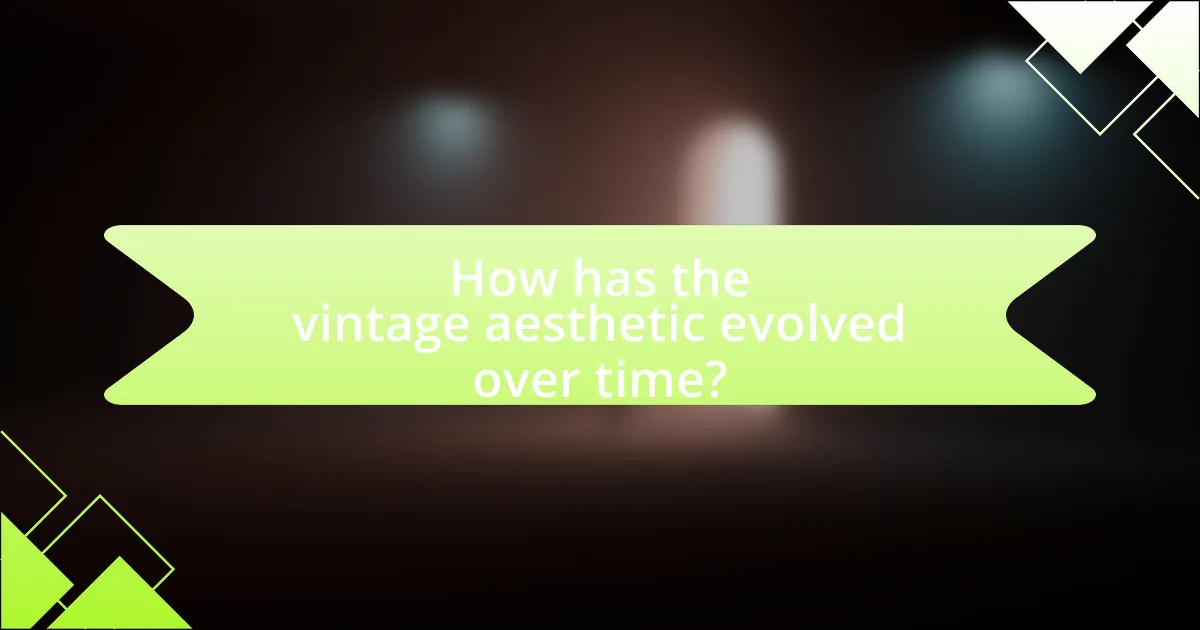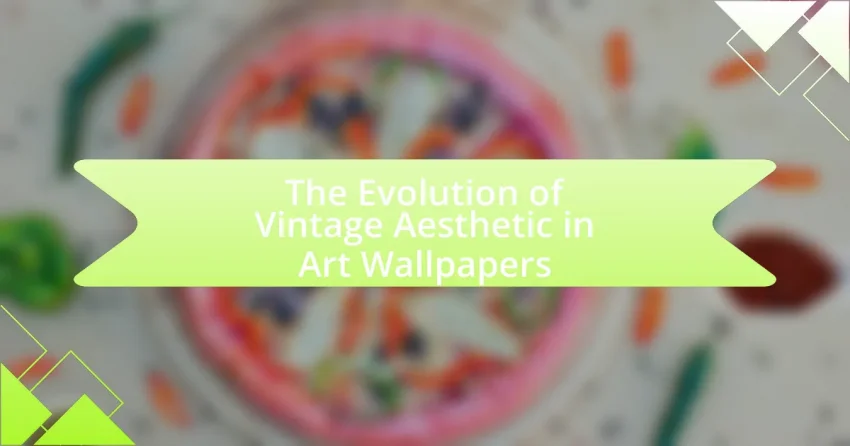The article explores the evolution of the vintage aesthetic in art wallpapers, highlighting its roots in historical artistic movements such as the Arts and Crafts Movement and Victorian design. It examines the defining characteristics of vintage wallpapers, including intricate patterns, muted color palettes, and nostalgic themes, while also discussing the impact of the Industrial Revolution on wallpaper production. Additionally, the article addresses how cultural movements have shaped vintage designs, the practical applications of these wallpapers in modern interiors, and tips for selecting and preserving authentic vintage pieces. Overall, it provides a comprehensive overview of how vintage aesthetics continue to influence contemporary design trends.

What is the Vintage Aesthetic in Art Wallpapers?
The Vintage Aesthetic in Art Wallpapers refers to a design style that draws inspiration from past artistic movements, particularly those from the late 19th and early 20th centuries. This aesthetic is characterized by its use of muted color palettes, intricate patterns, and nostalgic motifs that evoke a sense of history and charm. For instance, wallpapers featuring floral designs, damask patterns, or art deco elements exemplify this style, often reflecting the craftsmanship and attention to detail of earlier eras. The popularity of vintage aesthetics in contemporary interiors highlights a cultural appreciation for nostalgia and the timeless appeal of classic design elements.
How did the vintage aesthetic emerge in art wallpapers?
The vintage aesthetic in art wallpapers emerged as a response to the industrialization and mass production of the late 19th and early 20th centuries, which led to a revival of traditional craftsmanship and historical design motifs. This movement was characterized by the incorporation of floral patterns, intricate designs, and nostalgic themes that harkened back to earlier artistic styles, such as Art Nouveau and Victorian design. The Arts and Crafts Movement, spearheaded by figures like William Morris, emphasized handmade quality and organic forms, influencing wallpaper designs that sought to evoke a sense of history and authenticity. As a result, vintage wallpapers became popular for their ability to create warm, inviting spaces that reflected personal taste and a connection to the past.
What historical influences shaped the vintage aesthetic in wallpapers?
The vintage aesthetic in wallpapers has been shaped by several historical influences, including the Arts and Crafts Movement, Victorian design principles, and the revival of historical styles during the early 20th century. The Arts and Crafts Movement, which emerged in the late 19th century, emphasized handcrafted quality and natural motifs, leading to intricate floral patterns that became popular in wallpaper design. Victorian design principles, characterized by ornate and elaborate styles, contributed to the use of rich colors and complex patterns in wallpapers. Additionally, the early 20th century saw a revival of historical styles, such as Art Nouveau and Art Deco, which further influenced the vintage aesthetic by incorporating organic forms and geometric designs. These movements collectively established a foundation for the vintage wallpaper aesthetic that continues to resonate today.
How did cultural movements contribute to the development of vintage wallpaper designs?
Cultural movements significantly influenced the development of vintage wallpaper designs by reflecting the aesthetic values and social changes of their times. For instance, the Arts and Crafts movement in the late 19th century emphasized handcrafted quality and natural motifs, leading to intricate floral patterns in wallpapers that celebrated craftsmanship. Similarly, the Art Nouveau movement introduced organic forms and flowing lines, which became prominent in wallpaper designs during the early 20th century, showcasing the era’s fascination with nature and beauty. The influence of these movements is evident in the revival of vintage wallpaper styles that draw on historical themes, demonstrating how cultural shifts shape design trends and consumer preferences.
What are the defining characteristics of vintage aesthetic in art wallpapers?
The defining characteristics of vintage aesthetic in art wallpapers include intricate patterns, muted color palettes, and nostalgic themes. Intricate patterns often feature floral designs, damask motifs, or geometric shapes that evoke a sense of craftsmanship typical of earlier design eras. Muted color palettes, such as soft pastels or earth tones, create a warm and inviting atmosphere, reminiscent of the 19th and early 20th centuries. Nostalgic themes often draw inspiration from historical art movements, such as Art Nouveau or Victorian styles, reflecting a longing for the past. These elements collectively contribute to the vintage aesthetic, making it distinct and recognizable in the realm of interior design.
What color palettes are commonly associated with vintage wallpapers?
Commonly associated color palettes with vintage wallpapers include muted tones, pastel shades, and earthy colors. These palettes often feature combinations such as soft pinks, faded blues, and gentle greens, which evoke a sense of nostalgia and warmth. Historical trends in wallpaper design from the late 19th to mid-20th century highlight the use of these colors, as they were favored for their ability to create inviting and cozy atmospheres in homes. The prevalence of floral patterns and damask designs in vintage wallpapers further emphasizes the use of these specific color palettes, reinforcing their association with the vintage aesthetic.
How do patterns and textures play a role in the vintage aesthetic?
Patterns and textures are fundamental to the vintage aesthetic as they evoke nostalgia and authenticity associated with past eras. Vintage designs often feature intricate floral patterns, geometric shapes, and rich textures that reflect the craftsmanship of earlier times, such as Art Deco or Victorian styles. For instance, the use of damask patterns and aged textures in wallpapers can transport viewers to a specific historical context, enhancing the overall ambiance of a space. Historical evidence shows that these elements were prevalent in the decorative arts of the 19th and early 20th centuries, reinforcing their significance in creating a vintage atmosphere.

How has the vintage aesthetic evolved over time?
The vintage aesthetic has evolved from its origins in the early 20th century, characterized by a romanticized view of the past, to a more diverse and eclectic interpretation in contemporary design. Initially, vintage styles were influenced by specific historical periods, such as Art Deco and Victorian, which emphasized ornate details and craftsmanship. Over time, the vintage aesthetic has incorporated elements from various eras, blending styles to create a unique, personalized expression in art wallpapers. This evolution is evidenced by the rise of retro-inspired designs in the 1960s and 1970s, which embraced bold colors and patterns, and the resurgence of mid-century modern aesthetics in the 21st century, reflecting a nostalgia for simplicity and functionality. The continuous adaptation of vintage elements in modern design showcases the aesthetic’s ability to resonate with current trends while maintaining its historical roots.
What key periods mark significant changes in vintage wallpaper design?
Key periods that mark significant changes in vintage wallpaper design include the Victorian era (1837-1901), the Art Nouveau movement (1890-1910), and the mid-20th century modernism (1940s-1960s). During the Victorian era, wallpaper became widely popular, characterized by intricate patterns and bold colors, reflecting the ornate style of the time. The Art Nouveau movement introduced organic forms and flowing lines, emphasizing nature-inspired designs. In the mid-20th century, modernism shifted towards minimalism and geometric patterns, representing a departure from the elaborate styles of previous periods. These transitions in design reflect broader cultural and artistic movements, showcasing the evolution of aesthetic preferences in wallpaper.
How did the Industrial Revolution impact wallpaper production and design?
The Industrial Revolution significantly transformed wallpaper production and design by introducing mechanization and mass production techniques. This shift allowed for the rapid printing of intricate patterns and designs, making wallpaper more accessible and affordable to the general public. Prior to this period, wallpaper was often hand-painted or block-printed, which limited its availability and variety. The advent of steam-powered printing presses in the early 19th century enabled manufacturers to produce large quantities of wallpaper with diverse designs, including floral, geometric, and scenic motifs. By the mid-1800s, innovations such as the use of woodblock and lithographic printing further enhanced the complexity and detail of wallpaper designs, reflecting the artistic trends of the time and catering to the growing demand for decorative home interiors.
What role did the Arts and Crafts Movement play in the evolution of vintage aesthetics?
The Arts and Crafts Movement significantly influenced the evolution of vintage aesthetics by promoting handcrafted artistry and a return to traditional craftsmanship. This movement, which emerged in the late 19th century, emphasized the value of handmade goods over mass-produced items, fostering an appreciation for unique, artisanal designs. Key figures like William Morris advocated for the integration of art into everyday life, which led to the creation of wallpapers that featured intricate patterns and natural motifs, reflecting a deep connection to nature and historical styles. The movement’s focus on quality materials and craftsmanship laid the groundwork for the vintage aesthetic, encouraging later designers to draw inspiration from these principles, thereby shaping the visual language of vintage art wallpapers.
How have modern interpretations of vintage aesthetics changed?
Modern interpretations of vintage aesthetics have shifted towards a more eclectic and personalized approach, blending traditional elements with contemporary design principles. This change is evident in the use of bold colors, mixed patterns, and innovative materials that were not typically associated with vintage styles. For instance, the resurgence of retro wallpaper designs incorporates modern technology, such as digital printing, allowing for intricate patterns and textures that enhance the vintage feel while appealing to current tastes. Additionally, the integration of sustainable practices in production reflects a growing awareness of environmental concerns, further evolving how vintage aesthetics are perceived and utilized in modern contexts.
What contemporary trends are influenced by vintage wallpaper designs?
Contemporary trends influenced by vintage wallpaper designs include the resurgence of bold patterns, intricate florals, and retro color palettes. These elements reflect a growing preference for nostalgia in interior design, where homeowners seek to create warm, inviting spaces reminiscent of past eras. For instance, the use of large-scale botanical prints and geometric patterns, popularized in the mid-20th century, has seen a revival in modern homes, aligning with the trend of maximalism that emphasizes vibrant aesthetics. Additionally, the incorporation of vintage-inspired textures, such as linen and silk, enhances the tactile experience of wallpaper, further bridging the gap between historical styles and contemporary tastes. This trend is supported by market research indicating a 25% increase in sales of vintage-style wallpapers over the past five years, showcasing a clear consumer demand for these nostalgic designs.
How do modern technologies affect the reproduction of vintage wallpaper styles?
Modern technologies significantly enhance the reproduction of vintage wallpaper styles by utilizing advanced printing techniques and digital design tools. These innovations allow for precise color matching, intricate pattern replication, and the ability to produce wallpapers that closely mimic the textures and finishes of original vintage designs. For instance, digital printing technology can reproduce complex designs with high fidelity, ensuring that the aesthetic qualities of vintage wallpapers are preserved. Additionally, software programs enable designers to create and modify patterns easily, facilitating the revival of historical styles while maintaining authenticity. This combination of technology and artistry results in wallpapers that not only reflect the vintage aesthetic but also meet contemporary standards of durability and ease of application.

What are the practical applications of vintage aesthetic in art wallpapers today?
The practical applications of vintage aesthetic in art wallpapers today include enhancing interior design, creating nostalgic atmospheres, and serving as a marketing tool for businesses. Interior designers utilize vintage patterns and textures to evoke a sense of history and warmth in residential and commercial spaces. For instance, wallpapers featuring retro floral designs or art deco motifs can transform a room into a stylish, inviting environment. Additionally, businesses often employ vintage aesthetics in their branding to attract customers seeking authenticity and charm, as seen in cafes and boutiques that use vintage wallpaper to create a unique ambiance. This trend is supported by the growing consumer interest in retro styles, with a report from the National Retail Federation indicating that 60% of consumers appreciate vintage-inspired products.
How can vintage wallpapers enhance interior design?
Vintage wallpapers enhance interior design by adding character, depth, and a sense of history to spaces. Their unique patterns and textures can evoke nostalgia and create a focal point in a room, making it visually appealing. For instance, vintage floral designs or geometric patterns can complement modern furnishings, bridging the gap between different design eras. Additionally, the use of vintage wallpapers can reflect personal style and preferences, allowing homeowners to express individuality. Historical context shows that vintage wallpapers were often crafted with high-quality materials and intricate designs, which can elevate the overall aesthetic of a space.
What types of spaces benefit most from vintage wallpaper aesthetics?
Residential spaces, particularly living rooms, bedrooms, and dining areas, benefit most from vintage wallpaper aesthetics. These areas often serve as focal points for personal expression and comfort, making them ideal for the rich textures and historical patterns found in vintage wallpapers. For instance, vintage floral or damask patterns can evoke a sense of nostalgia and warmth, enhancing the overall ambiance of the home. Additionally, commercial spaces like boutique shops, cafes, and restaurants also gain from vintage wallpaper, as these environments aim to create unique atmospheres that attract customers and encourage longer visits. The use of vintage wallpaper in these settings can differentiate a brand and create a memorable experience, supported by studies showing that aesthetic environments can influence consumer behavior positively.
How can one effectively incorporate vintage wallpapers into modern decor?
To effectively incorporate vintage wallpapers into modern decor, one should select a focal wall to apply the wallpaper, creating a striking contrast with contemporary furnishings. This approach allows the vintage design to stand out while harmonizing with modern elements. For instance, pairing a floral vintage wallpaper with minimalist furniture can create a balanced aesthetic that highlights both styles. Additionally, using vintage wallpaper in smaller spaces, such as a powder room or an accent nook, can add character without overwhelming the overall design. Historical context shows that vintage wallpapers often feature intricate patterns and colors that can enhance the visual interest of a modern space, making them a valuable addition to contemporary interiors.
What are some tips for selecting vintage wallpapers?
When selecting vintage wallpapers, prioritize authenticity by verifying the wallpaper’s age and origin, as genuine vintage pieces typically date back to at least 20 years. Examine the condition of the wallpaper, looking for signs of wear, fading, or damage, as these factors can affect both aesthetics and value. Consider the design and color palette, ensuring it complements your existing decor and reflects the era you are interested in, as vintage wallpapers often feature distinct patterns and hues characteristic of their time. Additionally, research the historical context of the wallpaper to understand its significance and style, which can enhance your appreciation and decision-making process.
How can one identify authentic vintage wallpapers versus reproductions?
To identify authentic vintage wallpapers versus reproductions, examine the material and printing techniques used. Authentic vintage wallpapers typically feature natural fibers like paper or fabric, while reproductions often use synthetic materials. Additionally, authentic wallpapers may show signs of aging, such as yellowing or fading, which reproductions lack due to modern printing processes. Historical context also plays a role; for instance, wallpapers produced before the 1960s often utilized block printing or hand-painted techniques, whereas reproductions frequently employ digital printing methods. These distinctions help in verifying authenticity.
What maintenance practices are recommended for preserving vintage wallpapers?
To preserve vintage wallpapers, it is recommended to maintain a stable environment with controlled temperature and humidity levels, ideally between 60-70°F and 40-50% humidity. This helps prevent deterioration caused by moisture and temperature fluctuations. Regular dusting with a soft, dry cloth is essential to remove surface dirt without damaging the wallpaper. Additionally, avoiding direct sunlight is crucial, as UV rays can fade colors and weaken the material over time. Using a gentle, pH-neutral cleaner for spot cleaning can help address stains without harming the wallpaper. These practices are supported by conservation guidelines from institutions like the National Park Service, which emphasize the importance of environmental control and careful cleaning in the preservation of historic materials.
